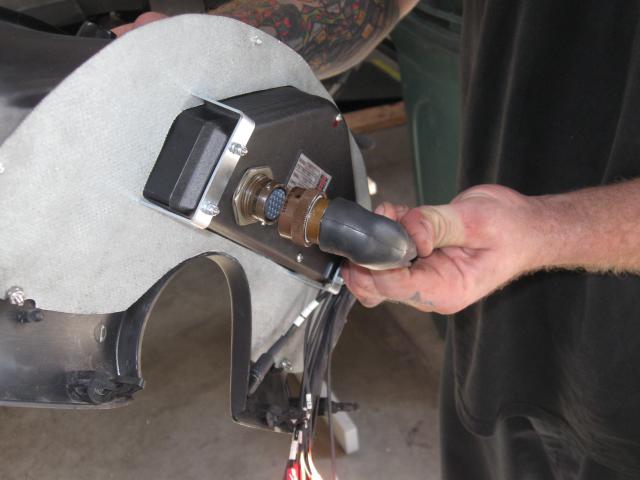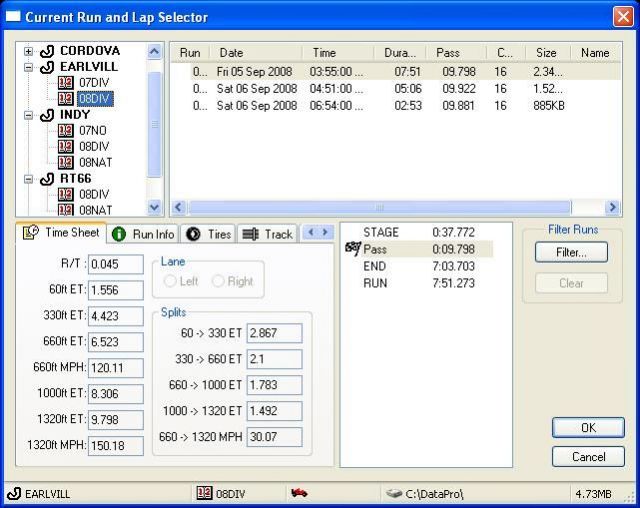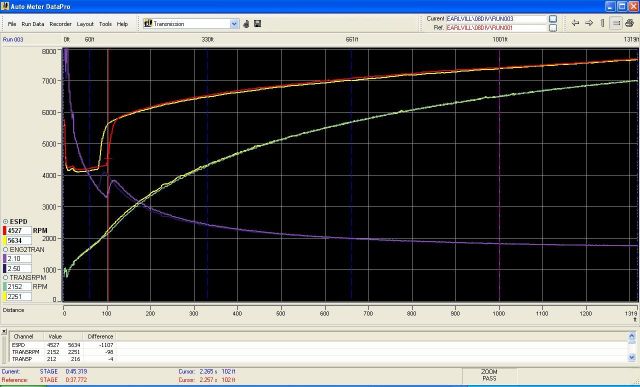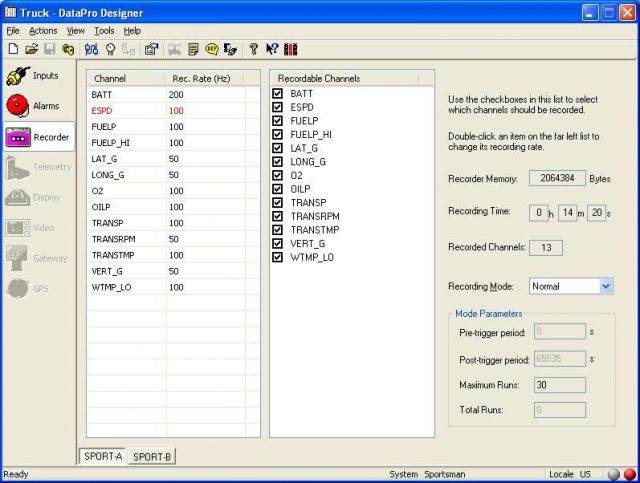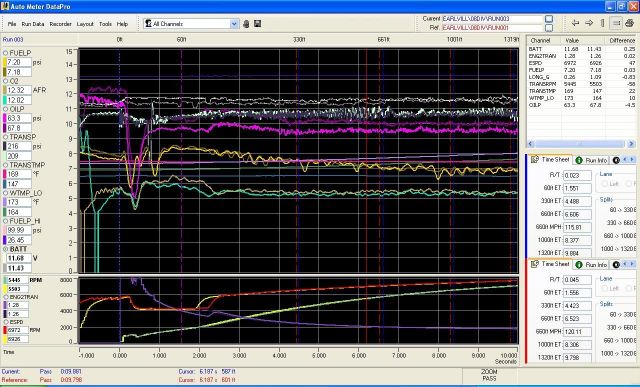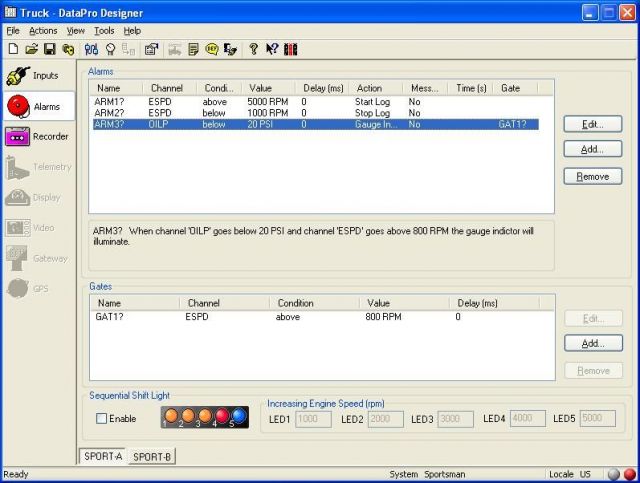Gauges are the racer’s and tuner’s best friends. Back in the muscle car era of the 60’s and 70’s, enthusiasts were lucky if they had anything more than the aptly named “idiot lights” giving them a soft glow from the dash as a vague warning that something was wrong. Thankfully gauges and data logging capabilities have steadily progressed, and today they are more advanced and capable than ever before.
Today, gauges aren’t just about giving warnings; they can also provide all the data you need to wring every ounce of performance potential from your race car. That’s why we recently got interested in Auto Meter’s Multi-Function Dash Logger (MFDL). The MFDL represents an all-in-one, fully customizable and expandable solution for both gauges AND data logging for your race car.
“The MFDL is a meant to be a complete dash replacement,” explained Marc Ericson, Director of Motorsports at Auto Meter, “not just a a fancy set of gauges.” The MFDL features an analog tachometer and shift light, a digital display panel and warning lights, and 13 built-in data input channels that can be monitored and logged. Three of those channels are internal G-Meters, one internal voltage channel, an engine RPM Channel. Ericson told us that, “Eight of the channels are completely user definable – you can choose what info is most important to you to log and monitor – fuel pressure, oil pressure, water temp, wideband – and it’s all accessible right from your dash board.”
“The internal g-meters will tell if the car experienced tire shake or if you moved out of the grove, and how hard the car left. The biggest thing they are used for is setting shift points. You can tell by looking at the g-meter if the car is still pulling, or if it laid over when the car was shifted. If it’s still pulling, you can raise the shift point, and if it laid over then shift point needs to lowered. The internal voltage meter will tell you the voltage during an entire run, and is a very useful tool if you are having fuel or ignition problems.”Ericson continues.
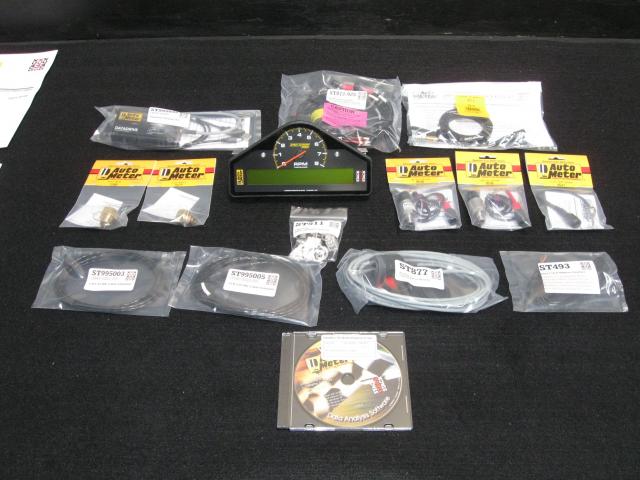
This is what a typical MFDL package from Auto Meter will look like - the dash unit, the main harness, whatever sensors you choose, the Datadrive Download Module, and the DataPro Designer software for your laptop.
Auto Meter Multi-Function Dash Logger Features
- 13 Loggable Input Channels
- 3 Built-In Internal G-Meters
- 2 Mb of Internal Memory
- Record Rate of up to 200 Samples Per Second
- MSS Sensor Connectors
- LED Back Lighting and LCD Display
- Fully Customizable with User Defined Warnings and Sensor Channels
- Included DataPro Data Logging Software for Your Laptop
- Ready to Run Right out of the Box
The MFDL’s Sensors and Data Collection
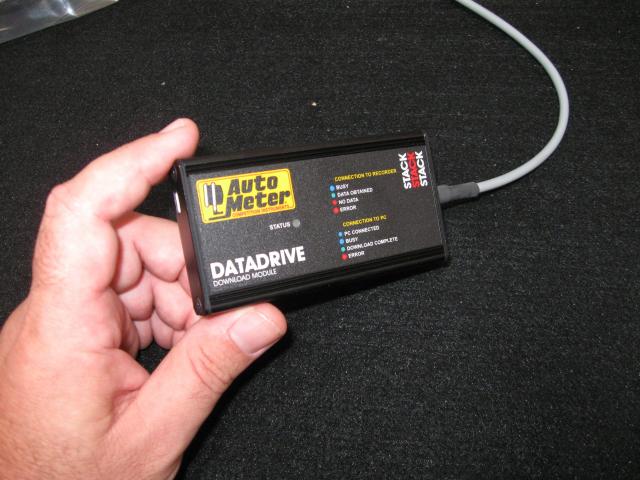
Any of the MFDL's sensors can be recorded at a rate of 200 samples per second thanks to this little bugger. The Datadrive Download Module is also the interface between the MFDL and your laptop.
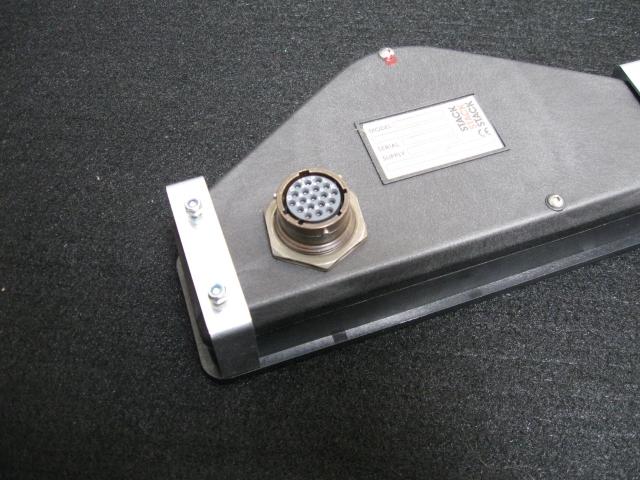
The MFDL unit has just one - that's right, one - simple connector on the back of it. The spinal chord of wires all mate up to this one 19-way military connector.

The MFDL's RPM sensor simply plugs into the main harness, and you run the fine black wire to your ignition box.
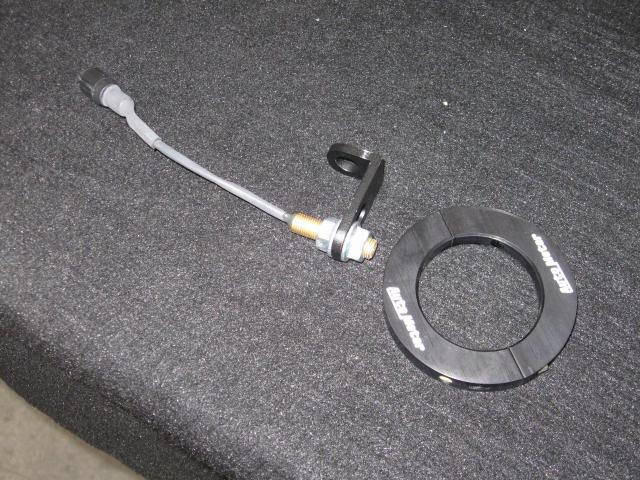
This is the MFDL's driveshaft sensor - which can help you identify clutch slipage or too much converter loss. It can also act as a speedometer in conjunction with the available wheel speed sensors for the MFDL. The driveshaft sensor picks up its signal from magnets embedded in the circular mount, which bolts right around the driveshaft.
These are only the basic sensors that the MFDL comes with, but there are literally dozens of other sensors available from Auto Meter. You can add pressure sensors, flow sensors, speed sensors, MAP sensors, temperature sensors – and the list goes on.
Gauges That Grow with Your Needs
A big advantage to using the MFDL is that it can grow with the needs of your car, or easily be adapted if you needed to make changes to what specific data you need to monitor.
Ericson tells us, “If you really wanted to go crazy with this, we also offer a 10 Channel expansion module that is a simple 1-wire hook up. You just hook it up to the logger itself, and you can run 10 extra channels. And the nice thing is that the expansion module can be mounted anywhere in the car. The units themselves are sealed. You could take both the MFDL and the expansion module, fire them up and dump them in a bucket of water, and they will operate fine. So, you could realistically take the expansion module and mount it out in the engine compartment if you needed to, or even in the back if you needed it to say, monitor your shocks.”
You can choose what info is most important to you to log and monitor – fuel pressure, oil pressure, water temp, wideband – and it’s all accessible right from your dash board.
In addition to the ability to log almost any aspect of your car that you choose, one of the biggest advantages to using the MFDL over traditional gauges is being able to set up user defined warnings. Ericson tells us, “Let’s say you wanted a warning if your engine dropped below 20 PSI of oil pressure. If your pressure dropped that low, a warning light would go off, and the face of the MFDL would read ‘Low Oil Pressure’, and also give you a numeric value right on there on the dash. Another neat feature is that you can ‘gate’ the warnings – meaning the alarms will only function when the engine is running. You could tell the MFDL, for example, ‘I only want to see this warning light when the engine is turning at least 300 RPM’s.’ So, you don’t have to be sitting in the staging lanes with just the key on, and a bunch of warnings going off.”
The MFDL can crunch a ton of data at once, but just how does it feed all that info back to you in a useful way? Ericson says, “All of the channels that display on the dash are also user definable. You can choose 4 data channels with the name next to them, or you can have 6 channels with just the value and no name. If you add an expansion module you can ‘layer’ the display to view every sensor you have logging in real-time. If you hook up the MFDL to a lap-top you can view every sensor running at once in real-time, in addition to logging.”
Weighing Out the Real Costs: MFDL vs. Traditional Gauges
Now, we know what you’re thinking: ‘This thing looks great, but there is no way I can afford this fang-dangled new contraption on my meager racing budget.’ Well, you might be surprised just how affordable the MFDL can be if you take a step back and look at the big picture. Ericson tells us,“When you are comparing the cost of using the MFDL versus traditional gauges, you have to compare apples to apples. You can get a set of short sweep gauges and a tach for just over $400, but you won’t have anywhere near the capabilities of the MFDL. You could get similar warning functions with the elite series gauges, but no playback or logging – and they would run around $1300 for four gauges and a tach.”
The MFDL with four gauges and a tach would run you only around $250 more, for a lot more features and expandability. The MFDL may be more expensive to buy into at first, but the cost to add a new sensor is about half of what it would cost you to buy a new gauge with warning features. With the MFDL you would just simply have to buy the new sender.
MFDL Install Process
Another advantage to the MFDL over traditional gauges is the ease of installation. You run a power and a ground wire, then there is just one connector in the back of the unit for the sensor harness. After that, it’s plug-and-play. You could have the whole unit in or out of the car in less than a minute. Also, when you order your sensors, you can specify how much cable you need for each sensor in two-foot increments. That way you don’t end up with way more cable than you need, or find yourself having to cut down and re-crimp your connections. Every cable comes with the terminal already connected with a Sure Sealed connector, so they are also completely weatherproof.
Of course, Auto Meter strongly suggests that you get familiar with all of the functions of the MFDL before you actually install it in the car.
With that many available sensors and all of those fancy electronics, you might expect the install of this thing to be pretty difficult. However, we actually found the MFDL to be a breeze to install. Click through our pics below to see how we went about mounting up the MFDL in the car.
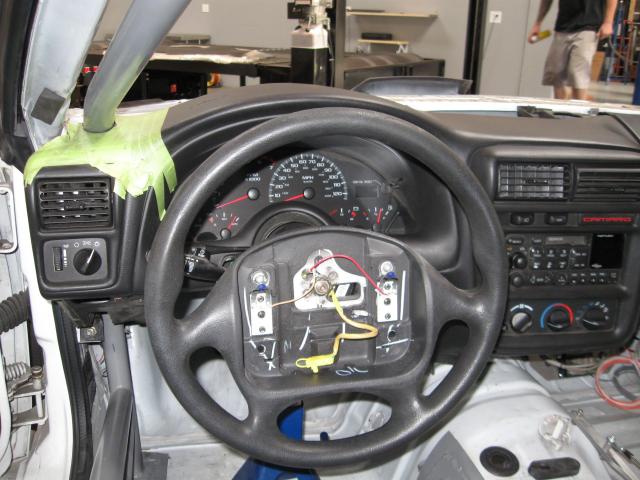
This is where our MFDL's final home will be, nestled right behind the steering wheel of a 4th Gen Camaro. To get the stock gauge cluster out of the car we had ended up having to unbolt the steering column and drop it down a few inches.
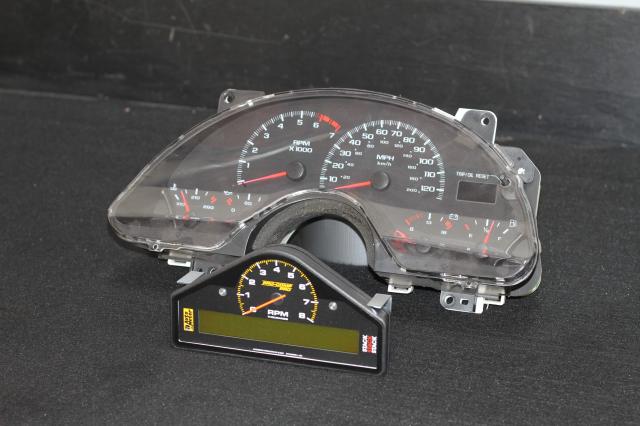
Comparing the MFDL to the stock dash, you will notice just how compact the MFDL really is. But don't let its size fool you, this little module has a ton of logging and monitoring capabilities that your crusty old dash could only dream of...
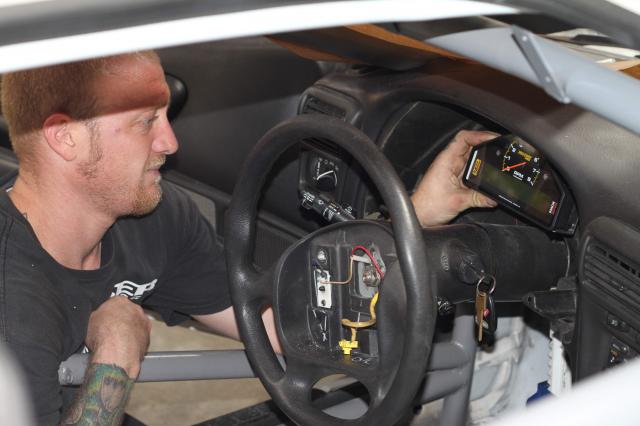
After popping out the old dash, we did a quick mock up to get an idea of how the MFDL would fit and where we would need to place it.
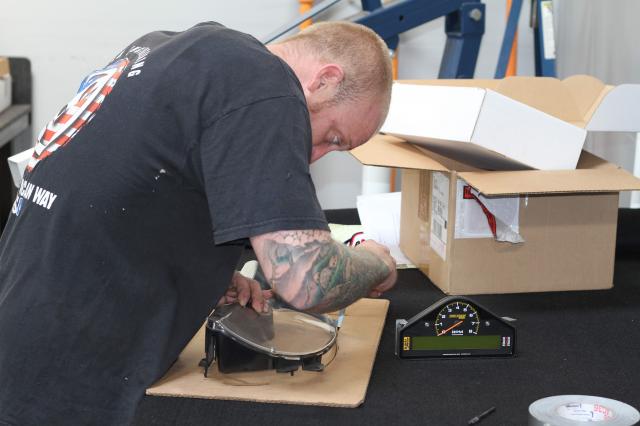
We used the plastic off of the stock bezel to make a cardboard template. From there, we used our template to cut the correct shape in a sheet of carbon fiber.
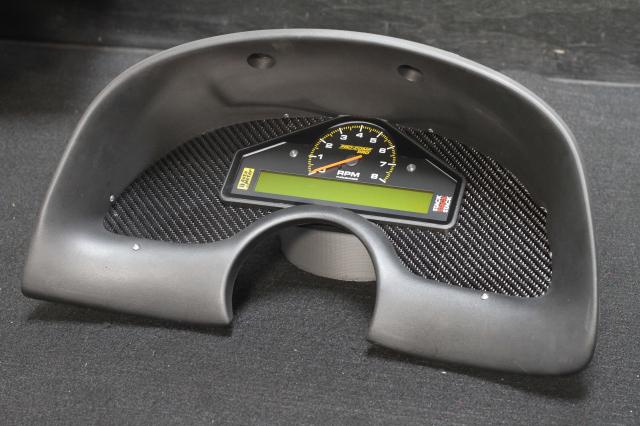
Once the carbon fiber sheet fit inside the stock bezel, we punched out an opening for the MFDL. The finished product looks pretty slick, don't you think?
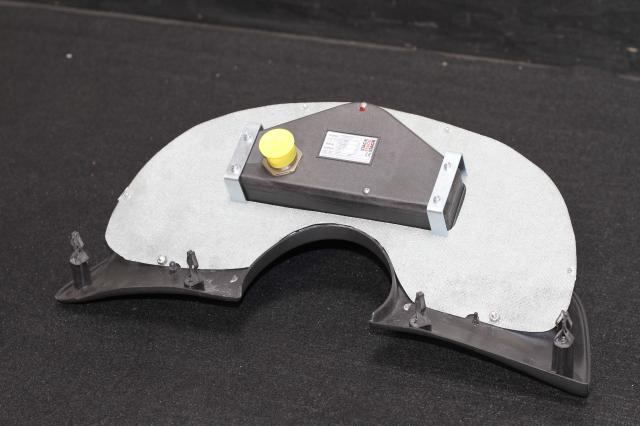
We reinforced the back of the bezel with some 16ga. steel and gave the MFDL's mounting brackets something firm to push against.
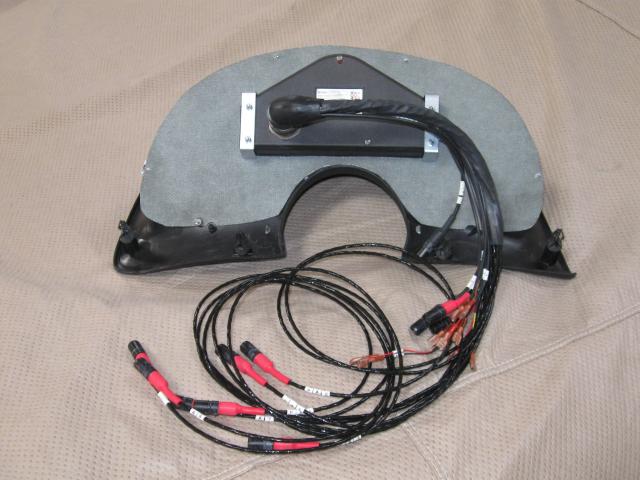
Most of the sensor connections go together easily with Mini Sure Seal weatherproof 4-pin connectors.
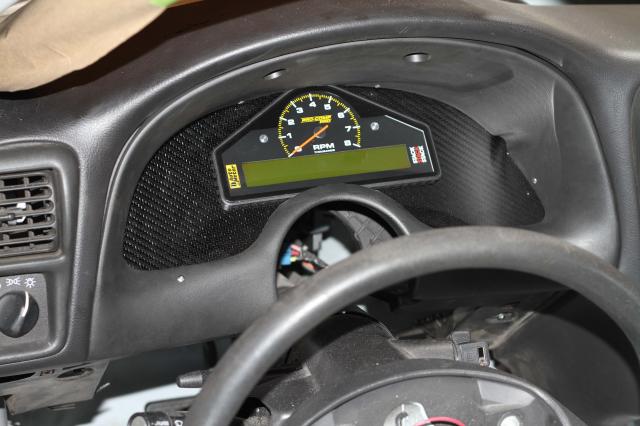
Once we had the MFDL mounted, it was just a simple matter of bolting the bezel back in the Camaro and putting the steering column back in its original position.
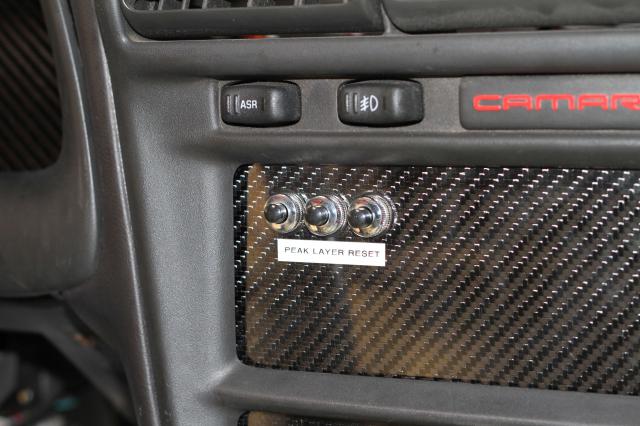
These three switches control the basic functions of the MFDL. "Peak" will display the peak values for the channels logged, giving you the tell-tales of what is going on with your car. "Layer" quickly pressed will toggle the MFDL's display layers, and pressed for 2 seconds will start and stop data logging. Care to take a wild guess what "Reset"does? For easy access we mounted them where the radio stack was formerly located.
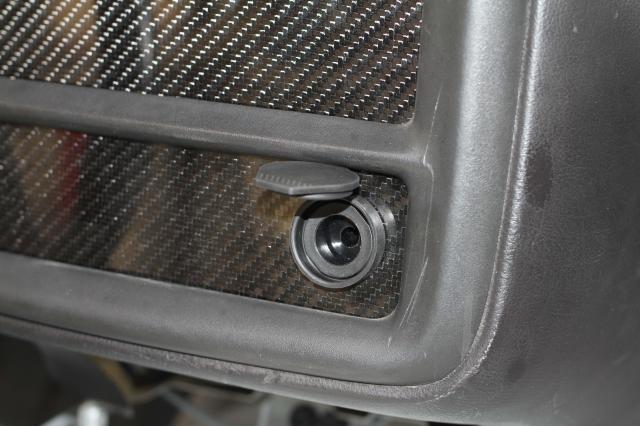
This connector is the DataPro's Download connector, and it is the MFDL's connection to the outside world, and where you will be able to extract all the valuable information it records about your car.
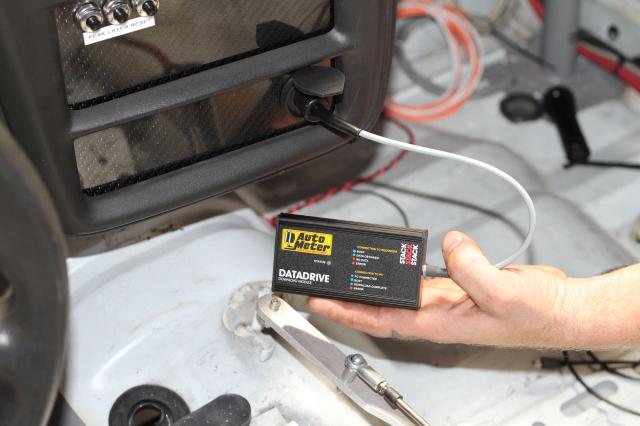
Data logging with the MFDL can either be started by simply pressing the "Layer" button, or when the engine reaches a predetermined RPM that you set through the DataPro Designer software. The MFDL's LCD screen will also display a message when logging has started and stopped. The MFDL can store up to 30 runs worth of data, and once the data has been recorded it can be downloaded to your laptop through CAN-USB interface cable. It is even possible to set up the DataPro to start downloading as soon as it connects with your computer.
Software
What good is the MDFL without good software to review and analyze your data. Auto Meter includes – at no charge – the DataPro Analysis Software with the Pro-Comp Pro MFDL. It’s compatible with Microsoft Windows XP and Vista equipped computers, and we’re going to show you some of the coolest features of the software.
With the DataPro, you can sort recorded data by track and record important information about track and vehicle setup conditions for later reference, utilizing the Logbook feature. Recorded runs are time and data stamped when they are recorded rather than when they are downloaded, so that you know which pass was which event if you don’t have time to download your data between runs.
DataPro Designer makes setting up your new system or changing / adding sensor channels pretty simple with Drag and Drop functionality. Locate the sensor you’ve plugged into the system from the menu on the left, drag it onto the input channel that matches the sensor’s cable connection location, drop it in the box for that location, select a channel name from the drop down menu and you’re done!
One cool thing about the DataPro software is that it now allows you to view data based on distance or time. So essentially, you’ll know exactly when and where a particular condition occurred during your run. You can also compare runs based on these two analysis formats for a more complete understanding of how your vehicle setup and track conditions affect your performance.
One of the configurable options inside the DataPro is allowing you to get the most out of your system and time at the track by dialing in your channel sample rates. Sampling rates are user selectable up to 200 Hz (samples per second), per channel. DataPro Designer instantly informs you of how your choices impact your available recording time.
Data hounds and drag racing enthusiasts will really love this screen, as you can personalize your Auto Meter DataPro software to suit your specific needs. View as much or as little data as your analysis requires, and compare data channels in groups that make sense when viewed together. Plus you can create custom layouts that show you the data that you want in the format that you want to see it. Because you can log in your time sheets, you can store all of your recorded e.t.’s right into the software.
Probably the coolest intersection between data analysis and data logging is the fact that the AutoMeter DataPro Designer software allows you to customize alarms and recording triggers specific to your vehicle. Dial in the visual warning for your Ultra-Lite Pro or Pro-Comp Pro CAN gauges or your MFDL, and then gate them to prevent false warnings. A gate is simply another qualification that has to occur when the alarm parameter is reached in order to trigger the alert. Example: A low oil pressure alarm by itself will trigger whenever oil pressure is below the alarm point, even when the engine is not running. To remove this false alarm and make the alert system mean more to the driver, add an engine RPM gate equal to your engine idle speed. Now you’ll only receive a low oil pressure alert when both the engine is running an the oil pressure is low!
Overall
Overall, we were very impressed with the Multi-Function Dash Logger’s capabilities right out of the box, as well as how easy it actually is to install. It’s nice to not have a rat’s nest of gauge wiring behind the dash. It should prove to be an invaluable tool in helping a racer extract every ounce of potential from their car.





